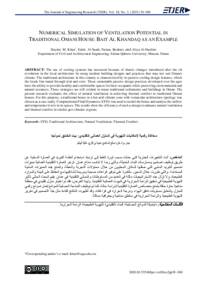Document
Numerical simulation of ventilation potential in traditional Omani house : Bait Al Khandaq as an example.
Identifier
DOI:10.53540/tjer.vol18iss2pp91-100
Source
The journal of engineering research (TJER), v. 18, no. 2, p. 91-100
Contributors
Other titles
محاكاة رقمية لإمكانات التهوية في المنزل العماني التقليدي : بيت الخندق نموذجًا.
Country
Oman.
City
Muscat
Publisher
College of Engineering, Sultan Qaboos University.
Gregorian
2021
Language
English
English abstract
The use of cooling systems has increased because of drastic changes introduced after the oil revolution in the local architecture by using modern building designs and practices that may not suit Oman's climate. The traditional architecture in this country is characterized by its passive cooling design features, which the locals fine-tuned through trial and error. These sustainable passive design practices developed over the ages have the ability to provide healthy and comfortable spaces for their occupants while preserving environmental and natural resources. These strategies are still evident in many traditional settlements and buildings in Oman. The present research evaluates the effect of natural ventilation in achieving thermal comfort in traditional Omani houses. For this purpose, a traditional house in a hot-arid climate zone with vernacular architecture typology was chosen as a case study. Computational Fluid Dynamics (CFD) was used to model the house and analyse the airflow and temperature levels in its spaces. The results show the efficiency of such a design to enhance natural ventilation and thermal comfort in similar geo-climatic regions.
ISSN
Online: 1726-6742
Print: 1726-6009
Hijri
1446
Arabic abstract
أدت التغيرات الجذرية التي حدثت بسبب ثورة النفط إلى ازدياد استخدام أنظمة التبريد في العمارة المحلية عن طريق توظيف تصاميم وممارسات البناء الحديثة، والتي ربما لا تناسب مناخ عمان. تزخر العمارة التقليدية العمانية بميزات تصميم التبريد السلبي التي صقلها السكان المحليون من خلال محاولات التجربة والخطأ، وتتمتع هذه الميزات السلبية المستدامة - التي طورت خلال السنين - بالقدرة على توفير فراغات صحية ومريحة لشاغليها مع الحفاظ على البيئة والموارد الطبيعية. ولا تزال هذه الاستراتيجيات ماثلة في العديد من المستوطنات والمباني التقليدية في عمان. يقيم البحث الحالي تأثير التهوية الطبيعية في تحقيق الراحة الحرارية في البيوت العمانية التقليدية. ولهذا الغرض، فقد تم اختيار منزل تقليدي في منطقة مناخية حارة جافة يتمتع بخصائص العمارة التقليدية لدراسة حالة، كما تم توظيف النمذجة الحسابية للموائع لعمل نموذج رقمي للمنزل ولتحليل مستويات تدفق الهواء ودرجة الحرارة في فراغاته، وقد أظهرت النتائج كفاءة مثل هذا التصميم في تعزيز التهوية الطبيعية والراحة الحرارية في مناطق مناخية وجغرافية مماثلة.
Category
Journal articles

